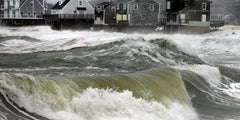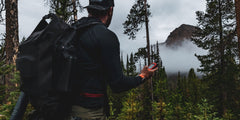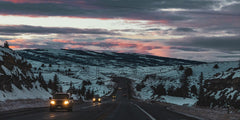
A few years back, I was on a New Years Eve backcountry ski mission to a 10th Mountain Division Hut. After a day of fighting through extremely cold temperatures and deep snow on skis and snowmobiles, we were faced with an avalanche-prone approach to the hut.
As the sun dropped below the horizon, the temps plummeted, and as we were supposed to be warming up by a fire in the cabin, we were facing a long, cold hike back to our vehicles. After a few miles, I was quite a ways ahead of some of the other members, and decided a fire would be a great way to rejuvenate everyone, dry out gear, and regroup before the final few miles push home.
The fire was a game-changer. It brought smiles to several tired faces, warmed up some cold extremities, and made our final push home much more enjoyable.
With cold and snowy weather, starting a fire can be a tricky task. And I recommend practicing before it becomes necessity. With that said, here are some quick instructions on how to get a fire going in the most cold and wet conditions:
BEFORE YOU GO:
I recommend a few key pieces to make fire starting significantly easier in wet and cold conditions:
- My rule of thumb is to always carry several BIC lighters. Bic lighters are sealed (something like a Zippo is not) and exceptionally durable and consistent. I much prefer a lighter over matches as you can hold a flame on your fuel much longer, helping raise the temperature and dry out the material which will then create a flame.
- Cotton balls dipped in petroleum jelly: As I mentioned above, in the winter or in wet weather, if you’re unable to find perfectly dry fuel, you’ll have to start by drying out your tinder, or at least raising the temperature to a point where it can ignite. Cotton balls will burn for a much longer time, giving you a better opportunity to get your fire going.
- If you haven’t brought these things, get creative – maybe you can soak a sock in gasoline from a snowmobile, or have paper towels on hand to help get things started.
GATHER TINDER:
The first step in starting a fire in the snow is to gather dry tinder and kindling. This can include things like dry leaves, twigs, and small branches. It is important to make sure that the tinder and kindling is dry, as wet materials will not ignite easily. In a snowy or wet environment, look for dead trees or brush, and pull kindling from under the canopy of the tree – this will be your best source of dry and dead fuel. It’s worth mentioning to make sure you collect a significant amount of kindling and branches before attempting to start the fire, as once the fire is going, you’ll want to keep a close eye on it and continue to feed it. Having a fire start, only to go out, is demoralizing.
FIND A GOOD SPOT
Next, a spot for your fire. This is best done by digging down to the ground beneath the snow, as the ground will be less likely to be wet than the surface of the snow. Once you have cleared a spot, you can create a fire ring or pit using rocks or logs to contain the fire. Having rocks near the fire will warm the rocks and create a source of heat for a long time after the fire has gone out. Building a rock foundation will also keep moisture separated from the bottom of your fire. One final suggestion is to build your fire next to a large structure that will reflect heat back towards you. A rock ledge, or big tree are great options.
Once you have your tinder, kindling, and fire ring in place, it's time to start the fire. You can use a fire starter, such as a magnesium fire starter, a stormproof match, or a lighter, to ignite your tinder. Having the ability to keep a flame on a piece of kindling for a longer amount of time is an advantage over something like a match, as it may allow the kindling to dry out and eventually start.
Once the tinder is lit, add the kindling to the fire, making sure to keep it dry and protected from the snow.
As the kindling burns and the fire grows, you can add larger logs to the fire. Remember to keep the fire small at first and slowly build it up. It's also important to make sure that the fire is out of the wind, but not too close to any flammable objects.
It’s worth mentioning that once you’re done, or leaving, make sure the fire is fully extinguished by covering it with dirt or snow.




